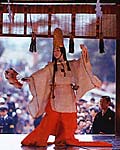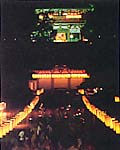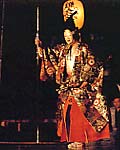January
| 1st |
Many people flock to temples and shrines, some dressed in kimono, for the first worship of the year. In Kamakura, cars are not allowed to go inside the city during those three days. For walkers, it may be a good chance to visit other shrines and temples that are not much crowded. |
|---|---|
| 4th |
Chona Hajime {pronounced cho-nah-hah-gee-meh} Ritual at Tsurugaoka Hachimangu Shrine Chona means an adz and hajime "first use of the year". In commemoration of the ritual Yoritomo Minamoto, the founder of the Kamakura Shogunate, performed at the time he inaugurated this shrine, the ceremony takes place on this day at 1:00 p.m. .
Chona means an adz and hajime "first use of the year". In commemoration of the ritual Yoritomo Minamoto, the founder of the Kamakura Shogunate, performed at the time he inaugurated this shrine, the ceremony takes place on this day at 1:00 p.m. . |
| 5th |
Joma Shinji {joe-mah shin-gee} at Tsurugaoka Hachimangu Shrine Joma means "keep evil spirits away" and shinji "Shinto ritual". Archers shoot arrows, at a target 27 meters away, on whichthe letter oni or devil is marked. By hitting the target, they wish the devil be exorcised. |
| 10th |
Ebisu {eh-bee-soo} Festival at Hongakuji Ebisu, one of the Seven Deities of Good Fortune, is the Deity of Commerce. Traditionally, January 10 is the day for Ebisu. The Ebisu Festival can be observed at all the shrines sacred to the deity. |
| 13th |
Gomataki Kuyo {go-mah-tah-key koo-yoh} or Holy Fire Rite for Invocation at Kokuzo-do located near Joju-in Goma is Homa in Sanskrit, a holy fire for invocation. |
| 15th |
Sagicho {sah-ghe-cho} Ritual at Tsurugaoka Hachimangu Shrine Gicho is a stick used by ancient people for hockey-like game and sa means three. Today, Sagicho means a sort of fire festival. People bring the New Year decorations and talismans, made of pines, sacred straw festoon etc. to the Shrine and the Shrine burn them with sacred fire after purification rituals. Religious people never throw away those sacred objects in awe of the divine wrath. |
| 16th |
Enma (Yama)'s Fete at En'noji This is the first fete-day for Yama. By praying to Enma, the ruling judge in the netherworld, worshipers believe the Enma give divine favors to the wandering souls. |
| 22nd |
Taishiko {tye-she-koh} Festival at Hokaiji Temple Festival for carpenters, scaffolding men and those who are engaged in construction jobs. Taishi means a crown prince and in this particular case, Prince Shotoku (574-622), who contributed to the development of Buddhism in Japan and founded a number of temples. |
| 25th |
Fude Kuyo {foo-deh koo-yoh} at Egara Tenjin Shrine A memorial service in honor of used writing tools such as brush-pen, pencil, etc. Fude means a writing brush and Kuyo a memorial service. All Tenjin shrines are dedicated to the memory of Sugawara Michizane (845-903), a court noble and scholar. After his death, he was divinized as the deity of learning. Known also as an excellent calligrapher, Egara Tenjin holds this Fude Kuyo in his commemoration. |
February
| 3rd |
Setsubun {seh-tsu-boon} Festival at Tsurugaoka Hachimangu and other shrines and temples On the last day of calendar winter, which is called Setsubun, this festival takes place at popular shrines and temples, celebrating the end of winter and the beginning of warm spring. The practice of scattering beans, usually roasted soybeans, is part of the ceremony, thereby people try to ward off devils and bring in good fortune. Beans are thrown shouting "Out with the devil. In with fortune". At Tsurugaoka Hachimangu Shrine, TV personalities and other notables whose birth year coincides with the Chinese zodiac of the year are invited to throw beans. In front of 15,000-strong visitors, 600-kilogram beans are thrown every year. Kenchoji also has it at Hansobo. Setsubun is unique in that it is honored both by Shinto shrines and Buddhism temples.
On the last day of calendar winter, which is called Setsubun, this festival takes place at popular shrines and temples, celebrating the end of winter and the beginning of warm spring. The practice of scattering beans, usually roasted soybeans, is part of the ceremony, thereby people try to ward off devils and bring in good fortune. Beans are thrown shouting "Out with the devil. In with fortune". At Tsurugaoka Hachimangu Shrine, TV personalities and other notables whose birth year coincides with the Chinese zodiac of the year are invited to throw beans. In front of 15,000-strong visitors, 600-kilogram beans are thrown every year. Kenchoji also has it at Hansobo. Setsubun is unique in that it is honored both by Shinto shrines and Buddhism temples. |
|---|---|
| 8th |
Hari kuyo {hah-re-koo-yoh} at Egara Tenjin Hari is literally a needle, and Hari Kuyo is a memorial service in honor of used needles just like the Fude Kuyo. Nowadays, young women do not use needles, nor do they know how to sew. Until a couple of decades ago, however, needles had been one of the most important tools women had to use. Sewing is a technique required of women to master before marriage. The memorial service for needles was thus started years ago and it is still honored in various shrines. |
| 11th |
Daikoku Toe {dye-kok-toe-eh} at Choshoji On the final day of 100-day austere discipline, priests take a wash-down with cold water.
On the final day of 100-day austere discipline, priests take a wash-down with cold water. |
| 15th |
Nehan-e {neh-han-eh} Shaka or Sakyamuni in Sanskrit is believed to have passed away on this day and memorial services called Nehan-e are carried out in many temples. |


 Festive activities can be observed all over the city during the week such as parades, open-air tea ceremony. The festivals are sponsored by Kamakura Tourist Association (Phone:0467-23-3050) to attract as many tourists as possible at this best season of the year. It started in 1959 and more than 800,000 tourists visit here during the week. Among the tourist attractions are:
Festive activities can be observed all over the city during the week such as parades, open-air tea ceremony. The festivals are sponsored by Kamakura Tourist Association (Phone:0467-23-3050) to attract as many tourists as possible at this best season of the year. It started in 1959 and more than 800,000 tourists visit here during the week. Among the tourist attractions are: Beaches in Kamakura are a popular resort for the young, and even in winter you will see surfers off the coast. In summer, hordes of bathers crowd on the beach. From the opening days, makeshift locker-room will be available for the swimmers or sun-bathers. Kamakura has two beaches, one Yuigahama {you-e-gah-hah-mah} and the other Zaimokuza {zye-moh-koo-zah} divided by the mouth of the Nameri river.
Beaches in Kamakura are a popular resort for the young, and even in winter you will see surfers off the coast. In summer, hordes of bathers crowd on the beach. From the opening days, makeshift locker-room will be available for the swimmers or sun-bathers. Kamakura has two beaches, one Yuigahama {you-e-gah-hah-mah} and the other Zaimokuza {zye-moh-koo-zah} divided by the mouth of the Nameri river. Gaki is a famished devil or Preta in Skt. , one of the Six Stage in the netherworld. Simply put, this is a requiem mass for the repose of the departed souls, and all Buddhist temples except for Jodo Shin sect hold this mass. In case of Kenchoji, it holds twice, regular one and Kajiwara Segaki, which originates from a legend relating to Kagetoki Kajiwara (?-1200), a faithful retainer of Yoritomo Minamoto, the founder of the Kamakura Shogunate. At one time long ago, the moment the mass was over, a ghostly samurai on horseback arrived. Knowing his arrival too late, he appeared so sad that the chief priest held an extra mass for him. Later, he disclosed that he was the ghost of Kajiwara. Since then Kenchoji holds an extra mass called Kajiwara Segaki. The rite is held mostly by chanting sutra.
Gaki is a famished devil or Preta in Skt. , one of the Six Stage in the netherworld. Simply put, this is a requiem mass for the repose of the departed souls, and all Buddhist temples except for Jodo Shin sect hold this mass. In case of Kenchoji, it holds twice, regular one and Kajiwara Segaki, which originates from a legend relating to Kagetoki Kajiwara (?-1200), a faithful retainer of Yoritomo Minamoto, the founder of the Kamakura Shogunate. At one time long ago, the moment the mass was over, a ghostly samurai on horseback arrived. Knowing his arrival too late, he appeared so sad that the chief priest held an extra mass for him. Later, he disclosed that he was the ghost of Kajiwara. Since then Kenchoji holds an extra mass called Kajiwara Segaki. The rite is held mostly by chanting sutra.
 Roughly 400 paper-lanterns with hand-drawn pictures and poems are displayed in the shrine's precincts day and night. Passing through the large ring made of grass rope (called chinowa) is believed to give you good health.
Roughly 400 paper-lanterns with hand-drawn pictures and poems are displayed in the shrine's precincts day and night. Passing through the large ring made of grass rope (called chinowa) is believed to give you good health. A group of ten (8 men and 2 women) wearing grotesque or comical masks will leave the shrine usually at 2:30 p.m. and parade through the nearby street accompanied by portable shrine and festive music.
A group of ten (8 men and 2 women) wearing grotesque or comical masks will leave the shrine usually at 2:30 p.m. and parade through the nearby street accompanied by portable shrine and festive music. Open-air Noh play is performed starting at 5:30 p.m. and ending 8:00 p.m. All lights will be extinguished before the play to make the area dark and firewood will be burned to create an elegant atmosphere. Takigi literally means "firewood burning". Okina is the regular number played and sung at the very beginning every year. Some 3,000 spectators join the event on this night. If you want to join, you have to make request to the Association in advance with online-site to the Association.
Open-air Noh play is performed starting at 5:30 p.m. and ending 8:00 p.m. All lights will be extinguished before the play to make the area dark and firewood will be burned to create an elegant atmosphere. Takigi literally means "firewood burning". Okina is the regular number played and sung at the very beginning every year. Some 3,000 spectators join the event on this night. If you want to join, you have to make request to the Association in advance with online-site to the Association. For three days and night, priests at Komyoji sit in front of the statue of Amida (Amitabha in Skt.) in the main hall and continue to recite sutras. Originally, it used to be a service practiced by Jodo sect Buddhist and they chant sutra for ten days and nights continuously from October 6 to 15 on lunar calendar. Ju means "ten" and ya "night".
For three days and night, priests at Komyoji sit in front of the statue of Amida (Amitabha in Skt.) in the main hall and continue to recite sutras. Originally, it used to be a service practiced by Jodo sect Buddhist and they chant sutra for ten days and nights continuously from October 6 to 15 on lunar calendar. Ju means "ten" and ya "night". The Watch-Night Bell at temples throughout Japan start ringing at midnight to signal the end of the old year and the beginning of the new. The bells which will be rung 108 times as the year changes are believed to erase all our sins and rarefy our earthly desires and evil passions which are said to count 108. Some temples (Engakuji, Kaizoji, Komyoji, Jokomyoji, Jochiji, Zuisenji, Sugimoto-dera, Tokeiji, Hasedera, Hokaiji, Hongakuji, Manpukuji, Myohoji, etc) allow visitors to ring the bell on first-come, first-served basis, but only one ring per person.
The Watch-Night Bell at temples throughout Japan start ringing at midnight to signal the end of the old year and the beginning of the new. The bells which will be rung 108 times as the year changes are believed to erase all our sins and rarefy our earthly desires and evil passions which are said to count 108. Some temples (Engakuji, Kaizoji, Komyoji, Jokomyoji, Jochiji, Zuisenji, Sugimoto-dera, Tokeiji, Hasedera, Hokaiji, Hongakuji, Manpukuji, Myohoji, etc) allow visitors to ring the bell on first-come, first-served basis, but only one ring per person.